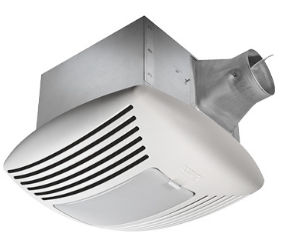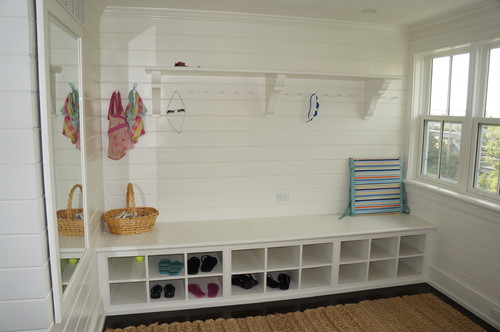A friend just completed an elegant gut renovation – down to the studs – of her home. She did everything right in terms of energy efficiency – installing insulation with an R-value considerably greater than what was required by Code, new windows and a geo-thermal heat pump. The work included new sheetrock, hardwood floors and interior doors. A fresh coat of paint and new draperies and furniture finished off the renovation. The end product is a lovely home that will bring her pleasure for years to come. But right now, her renovation is just one big headache…
After living in the home for just a week, she couldn’t figure out why she was having persistent headaches. Her doctor ran some tests. Everything was negative. And then he asked if she had made any other major changes in her life. Her doctor’s diagnosis upon hearing that she had just moved back into her renovated home? Your house is making you sick.
Americans spend 90% of their time indoors. So, if you’re building a new house or doing work on your existing home, there are some things you can – and should – do to make sure that the air you breathe inside your home is fresh and clean.
Image courtesy of Idea go at FreeDigitalPhotos.net
In general, 21st century homes are very “tight,” which is great from the standpoint of energy efficiency. We’re not paying to heat or cool air that then finds its way outside the home through leaky windows or walls. But this also means toxins that enter our homes have a much more difficult time finding their way back out. In fact, the LEED for Homes Reference Guide states that indoor “levels of pollutants run two to five times – and occasionally more than 100 times – higher than outdoors, according to the U.S. Environmental Protection Agency” (EPA).
Indoor Environmental Quality is one of the major credit categories in the LEED for Homes green building program. Sunset Green Home is selecting building materials and installing mechanical systems to ensure that the air inside the home is fresh and healthy.
LEED proposes three strategies for creating healthy indoor environments:
- Source Control – making sure that contaminants do not enter the home
- Source Removal – capturing pollutants that are already inside a home
- Dilution – ventilating a home using fresh air and exhausting pollutants to the outdoors
But you don’t need to go for LEED certification to have high quality air inside your home. Here are some practical ways that you can apply all three strategies within your home…
Source Control. Be aware of potential toxins and keep them from entering your home.
Many paints, adhesives and varnishes contain Volatile Organic Compounds (VOCs) that have the potential for dangerous offgassing inside your home. Read the labels! And choose low- or no-VOC coatings wherever possible. Many of us know that a “new paint” smell is not healthy. Low- and no-VOC paints are now produced by all of the major paint manufacturers such as Benjamin Moore, Sherwin-Williams and Valspar.
And dangerous toxins are lurking in other materials that we don’t think about. Furniture, carpeting, wall coverings and interior doors may also emit toxic gases into your home.
TruStile certified 75% recycled MDF doors with no added urea-formaldehyde (NAUF) featured in the 2014 New American Home, co-sponsored by NAHB and Builder Magazine
Take the time to learn what building materials are being used in your home, and specify those with the lowest offgassing potential. For example, medium-density fibreboard (MDF) is a very stable material that doesn’t warp. Given Sunset Green Home’s coastal location and proximity to the water, we plan to specify MDF interior doors. But we’re specifying MDF doors made by TruStile that contain “no added urea formaldehyde” (NAUF) resins, as urea formaldehyde is a known carcinogen.
In fact, the LEED green building program is so concerned about VOCs that many low-emitting building materials can earn a project ½ point each toward certification.
Radon gas is another dangerous pollutant that is linked to increased risk of lung cancer. The EPA publishes a radon risk map and a Consumer's Guide to Radon Reduction, and recommends that all homes be tested for radon gas. If your home is found to have an elevated level of radon, you will need to hire a qualified radon mitigator to install a system that will pipe the radon from under your home to prevent it from finding its way inside. LEED for Homes requires homes in the highest radon risk areas to incorporate radon-resistant building methods and offers credit to homes in lower risk areas if they voluntarily include such strategies.
Keep mold and mildew from forming by running bathroom fans, venting attic spaces, and maintaining relative humidity in the home in the range of 30% - 50%. The LEED green building program offers credits for projects that install bathroom fans with occupancy and/or humidity sensors that operate automatically when conditions warrant.
Pesticides and fertilizers are widely used outdoors and can be tracked inside on the bottoms of our shoes. One simple way you can prevent these toxins from entering your home is to remove your shoes or use walk-off mats just inside the door. In fact, LEED for Homes awards one point toward certification to projects that create a dedicated shoe storage area just inside the home.
Source Removal. If toxins find their way indoors, find a means to remove them.
For example, use high quality filters to remove pollutants from the air that circulates through your heating and air conditioning systems. Clean or replaces the filters regularly. LEED awards points to project that use high quality HVAC filters that remove very small particles from the air that circulates throughout the home.
Dilution. Introduce fresh clean air into your home to dilute any pollutants that are circulating in your air. If the air outside your home is clean, open your windows to bring in fresh air. If you live in a newly built home with a very tight building envelope, consider installing a mechanical ventilation system - an Energy Recovery Ventilator or a Heat Recovery Ventilator - that exhausts stale air and introduces fresh air into your home.
And, if you’re like my friend and have a recently renovated or new home, consider following the LEED protocols for a Pre-Occupancy Flush. According to the LEED for Homes Reference Guide, “flushing the house removes VOCs, ureaformaldehyde, and other air pollutants that remain after construction. These pollutants are mostly caused by off-gassing paints, adhesives, and sealants. Flushing the home also removes some of the dust and particulates that remain from construction.” Flush the house with fresh air for at least 48 hours by taking these steps:
· Open all windows and interior doors (including closets and cabinets)
· Run all fans (bathroom, kitchen and central air/heat system)
· Use additional fans to circulate the air within the home
· Clean or replace all central air/heat system filters at the end of the preoccupancy flush
Regardless of whether your home is LEED certified, you’ll breathe easier knowing you did what you could to improve your indoor air quality.











